
 Go to 2002 RSC Annual Report Index
Go to 2002 RSC Annual Report Index
Physical and Theoretical Chemistry
Disordered Materials
Professor Richard Welberry
http://rsc.anu.edu.au/research/welberry.php
This group combines diffuse X-ray scattering methods with computer simulation to deduce the arrangement of atoms and molecules in disordered crystals. Conventional crystal structure determination reveals only averaged arrangements, inadequate to explain some of the basic properties of many minerals, inorganic compounds, organic compounds and alloys that exhibit crystalline disorder. Diffuse scattering gives information on how neighbouring atoms or molecules interact with each other. Quantitative studies of diffuse scattering are, however, still rare because of the intrinsically very low intensities involved.
The group uses dedicated diffuse-scattering diffractometer systems based on curved position-sensitive wire detectors. These allow high quality diffuse scattering data to be efficiently recorded over large regions of diffraction space and provide a unique facility for tackling a whole range of complex structural problems.
The group's interests span a wide range of different fields, each presenting problems for which this specialised technique can give unique information. Areas in which we have applied the techniques include: disordered molecular crystals, guest/host systems such as urea inclusion compounds, non-stoichiometric inorganic materials and minerals (for example, the cubic stabilised zirconias, mullite and wüstite), flexible framework structures such as silica polymorphs and their analogues, alloys, and quasicrystal phases.
Much of the current effort of the group is concerned with the further development and exploitation of the least-squares method for directly fitting a Monte Carlo (MC) simulation to observed X-ray diffraction data, proposed for the first time in 1997. An ARC Discovery Grant bid to support this work was successful in the 2002 round. A second ARC Discovery Grant bid (jointly with the Withers Group) to support work to investigate the rôle of strain in disordered systems was also successful.
Refinement of Monte Carlo Models of Disordered Molecular Crystals
The automatic refinement method has been extended to investigations of various derivatives of benzil (reported last year), which contain additional static disorder and/or more internal degrees of flexibility. The main emphasis of the work is to develop the techniques whereby the diffuse scattering from a molecular crystal can be measured and analysed on a routine basis. Such an analysis provides information on how the molecules interact with each other that is not available from conventional crystal structure determinations. Studies have commenced during the year on three benzil derivative compounds. These are 4,4'-dimethoxybenzil, 4,4'-dimethylbenzil and 4-Cl,4'-methylbenzil. The figure below shows the quantitative agreement that has been obtained for observed and calculated diffraction patterns of the 4,4'-dimethoxybenzil compound.Further work has been been carried out on the adduct of azelaic acid, C9H16O4, and hexamethylenetetramine, C6H12N4. The interest in this compound relates to the fact that the orientational disorder in the acid molecules appears to be transmitted via the intermediary HMT molecules, which act like switches.
Work
has also continued on the optically anomalous material
1,5-dichloro-2,3-dinitrobenzene. The disorder in this material
represents a considerable step-up in complexity from previous studies
since it involves two types of static disorder. Not only do the
molecules crystallise in two basically different orientations with Cl
and NO2 interchanging position, but each of the NO2
groups is also orientationally disordered. As a result of the static
disorder, the whole molecule undergoes large local relaxational
displacements. The automatic refinement methodology has been an
invaluable tool in investigating this system. Although substantial
progress has been made in building a model of this disordered system,
a completely satisfactory model is still some way off. (with A.J.
Edwards,
D.J. Goossens, A.P. Heerdegen, and W.I.F. David [ISIS,
Oxon, UK], M. Gardon,
K. Schenk [U. Lausanne, Switzerland])
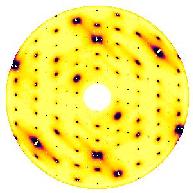
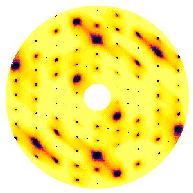
Observed and calculated diffraction patterns for the system
4,4'-dimethoxybenzil
'Size-effect'-like Distortions in Quasicrystalline Structures
We have carried out a study in which we have shown that by applying 'size-effect' distortions to a perfect Penrose tiling, on the basis that rhomb-edges which connect different types of vertices assume different lengths, we can obtain a diffraction pattern which shows remarkable similarity to the zero-level (h5=0) section of the observed diffraction pattern of decagonal Al71Co13Ni16 quasicrystals. In particular a central clearly-delineated decagon is observed, on the inside of which there is reduced intensity, and on the outside of which there is enhanced intensity. Such a transfer of intensity is characteristic of size-effect distortions in crystals but for these systems it is necessary to have disorder involving (at least) two types of atoms. In the present case the effect is observed with all vertices of the tiling pattern occupied by a single scatterer and the system remains topologically equivalent to the Penrose pattern with long range quasicrystallinity (see below). (with M. Honal)
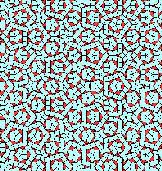
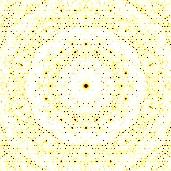
The distorted Penrose tiling pattern with its corresponding diffraction
pattern
High-pressure X-ray Scattering of Na1/2Bi1/2TiO3
Many of the outstanding properties in oxides are related to materials with an intrinsic nano-scaled local structure, where the different regions are characterized by competing chemical, structural and/or physical properties. One of the major challenges in the analysis of the nano-scaled oxides is experimental access to the local properties, which is often at best a difficult task, a fact that often inhibits the understanding of properties such as colossal magneto-resistance, giant piezo-electricity and high-temperature superconductivity. We have carried out an investigation of the relaxor ferroelectric Na1/2Bi1/2TiO3, considered as a model type of nano-structured oxide, by combining the parameter high-pressure with X-ray diffuse scattering (XRDS). We show that nano-scaled characteristics can be investigated to exceptional detail by combining such measurements with simulation of different diffuse scattering models. We observe two distinct structural disorders, one of which is characterized by the observation of asymmetric 'L-shaped' diffuse scattering features which are caused by planar polar defects in the perovskite structure. (with J. Kreisel, [Laboratoire Matériaux et Génie Physique, ENS de Physique de Grenoble, France], P.A.Thomas, [Dept. Physics, U. Warwick, UK], M.A. Glazer, [Clarendon Lab., U. Oxford, UK])

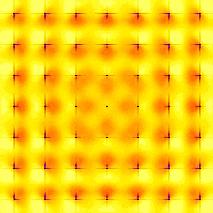
A model of the disordered structure of Na1/2Bi1/2TiO3 and its calculated diffraction pattern
Oxygen/Fluorine Ordering and Diffuse Scattering in K3MoO3F3
Bond valence sum calculations have been used to investigate the crystal chemistry of the elpasolite-related oxyfluoride K3MoO3F3 in order to obtain insight into the type/s of structural distortion (away from an ideal, high symmetry, elpasolite type parent structure) responsible for a characteristic, highly structured, three-dimensional diffuse intensity distribution. The first required type of local structural distortion corresponds to large amplitude MoO3F3 octahedral rotations while the second is associated with O/F ordering and associated induced Mo ion shifts. Monte Carlo modelling has been used to show how the latter, when coupled with an appropriate local crystal chemical constraint, can give rise to the observed structured diffuse scattering. Examples of different sections of the calculated diffraction pattern are shown below. The study is part of a wider search for diffraction evidence of oxygen/fluorine ordering in metal oxyfluoride systems. (with R.L. Withers, L. Norén, F.J. Brink)
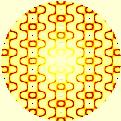
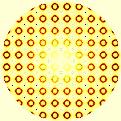
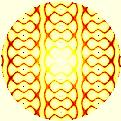
Three example reciprocal sections (100, 113, 331) of the
K3MoO3F3
system, calculated from a Monte Carlo model based on a simple
chemical constraint